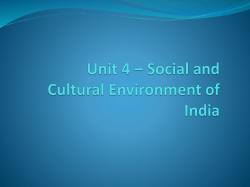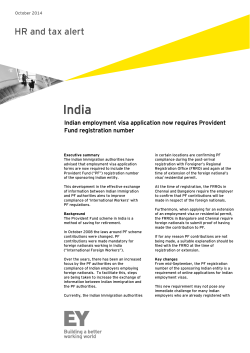
Gender and Nationalism in India International Perspectives on Gender Week 11
Gender and Nationalism in India International Perspectives on Gender Week 11 Structure of lecture Introduction and Context History: From Trade to Colony to Nationalism to Independence Colonialism, Nationalism and the ‘Woman Question’ Women’s Participation in Indian Nationalism Conclusions Introduction 3 million square kms 1.15 billion people (2010) 1947 - independence Biggest ever colony 1947: Partition: India and Pakistan 1971: independence for Bangladesh Context Multi-faith society Hinduism >50% Hindu caste system: a form of social stratification with castes hierarchically organized and separated from each other by rules of ritual purity. Brief history: from trade to colony Concentrate on colonial and post-colonial periods How did India become a British colony? How did Indians organise for independence? How did Indian women’s legal status change How did Indian women’s movement emerge? 1600 Elizabeth I granted Charter to East India Company 1700s Company bribing Indian Princes to secure trading Mid 1700s: militarization begins Late 1700s: Influence transformed into territory Cross-cultural mixing common 1773 First Governor-General appointed by Britain 1813: 78% duty imposed on Indian muslins imported into Britain (against 3.5%) 1829: Abolition of sati following campaign led by Indian Raja Ram Mohan Roy (1774-1833) 1856: Act permitting Hindu widows to remarry 1857: Anglo-Indian War – large and unsuccessful rising against British. End of inter-cultural mixing. 1858: India became British Crown Colony De-industrialization, famine, disease (1850: 55% depend on agriculture, 1921:73%) 1877: Queen Victoria: Empress of India Rise of Nationalism and Women’s Movement 1885: Indian National Congress founded 1891: Age of Consent Bill 1904: First Indian Women’s Conference 1906: Muslim League founded 1907: Mass picketing, boycotts 1914-1918: First World War – 47,000 Indians killed in service, 65,000 wounded 1915 Mahatma Gandhi entered Indian politics 1916: First Women’s University established 1917: Women’s Indian Association founded 1919: Government of India Act implemented very limited reforms: 3% of Indian adults given voting rights for Provincial Assembly 1919: Amritsar Massacre – 1,500 demonstrators shot dead by British troops 1920-22: Non-cooperation campaign led by Ghandi 1922: Ghandi suspended campaign. Tried that same year and sentenced to 6 years in prison by British 1925: National Council of Women in India founded 1927: Simon Commission on ‘reforms’ boycotted by Congress 1928: Congress publishes report on self-government 1930-1935: Satyagraha campaign, Salt March, Gandhi arrested again 1931: Ghandi released and suspended campaign to attend 2nd Round Table Conference to discuss dominion status What was Satyagraha? Campaign of non-violent civil disobedience Boycotting of imported goods Self-reliance: hand-weaving cloth Khadi a symbol of nationalism Non-payment of taxes Marches and demonstrations Translates as ‘Truth-Force’ Ongoing Struggles 1932: Civil disobedience resumed 1934: All India Women’s Conference demanded reform of Hindu personal law 1935: Government of India Act condemned by Congress and women’s organisations 1939-1945: Second World War, 2.5 million Indians fought, 24,000 killed Ghandhi split with Nehru and led 3rd non-violence campaign Towards Religious Divide 1940: Muslim League under Jinnah calls for separate Muslim state in Lahore Resolution P from Punjab A from Afghania K from Kashmir I S from Sind Tan from Baluchistan (plus Bengal & Assam) A N Independence & Partition 1942: India offered, and refuses, dominion status ‘Quit India’ movement 1946: New Labour Government in Britain starts preparing India for independence 1946-7: Increasing inter-religious violence 1947: Mountbatten appointed as last Viceroy, independence planned for June 1948 Independence brought forward to August 1947 37 days to decide line of partition 7.5 million Muslims moved from India to Pakistan 5.5 million Hindus moved from Pakistan to India Nehru and Mountbatten at Indian independence, 1947 Mass Migration Celebrating Indian Independence Day Partition: Before and After British India India following Partition and independence of Bangladesh Colonialism, Nationalism and the ‘Woman Question’ British Policies on Gender Equality Emphasise Indian women’s subordination to portray India as backward and unfit for self-rule Present British rule as essential to save Indian women Actual British record suggests full gender equality never envisaged – matrilineal family undermined; judicial system sought to impose moral constraints of upper-caste women on all Indian women Highlighting gender inequality was about legitimating continued colonial rule more than about helping women Indian Policies on Gender Equality Only when India governed itself could women’s position be improved Problem was state structures, not male power Early campaigns for women led by Indian men By early 20th century Indian women organising and linking cause to nationalism (reduced opposition) Women’s movement led by MC and took up MC issues – not representing all Indian women Supporting women’s suffrage was way for nationalists to claim moral high ground Full gender equality in family never envisaged by male nationalists Women’s Participation in Indian Nationalism Indian women played important roles in nationalist movement, both in domestic and public spheres Nationalist movement constructed women in particular ways Nurturers of nation: raising patriotic children, doing without men, weaving cloth, representing the ‘new woman’ but focussed on home and family, some hiding weapons and pamphlets Saviours of nation: Stepping into men’s shoes, demonstrating, boycotting, guerilla warfare for a few Many women entered the public sphere for the first time Women in the Quit India Movement Conclusions British influence began with East India Company in 1600s and shifted from trade to direct colonial rule Colonization brought under-development and resistance British response was to concede as little as possible and try to crush resistance The ‘Woman Question’ was central: notwithstanding well established Indian women’s movement from 19th century British claimed only they could save Indian women; nationalists claimed only independence would help but didn’t envisage full equality for ‘New Woman’ Women were central to Gandhi’s Satyagraha campaign, domestic sphere was politicized and some accessed public sphere, but often with limits Independence in 1947 brought Partition – what did it bring for Indian women?
© Copyright 2025












